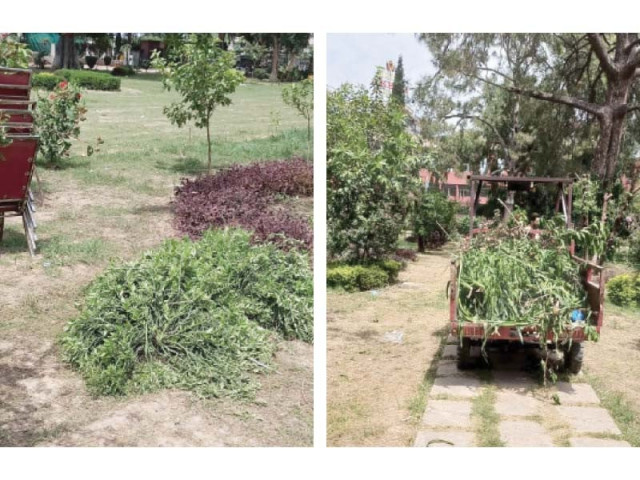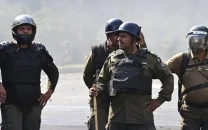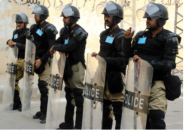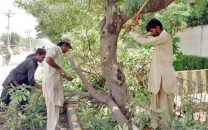Liaquat Bagh continues to shrink
Expansive park site of many historic gatherings, including two assassinations

The expansive Liaquat Bagh at the center of the city has a long and majestic history that dates back to settlements long before Rawalpindi was established around 500 years ago.
Once upon a time, it was part of a dense forest where the Indo-Aryans, pastoralists who migrated from Central Asia, were among the earliest settlers. They chose the area adjacent to Liaquat Bagh due to a clear stream of flowing water, which we know today as Nullah Leh. It exists to this date and is known as the ‘Arya Mohalla’.
From 1880 to 1947, Hindu families cremated their dead here with the ashes scattered in the stream and also performed purification rituals in it. Hindu and Sikh women would also wash household utensils and clothes in the water channel which was also used by locals to take baths.
The dense forest of Liaquat Bagh also served as an ingress point for Afghan invaders whenever they attacked the subcontinent. Their troop would be stationed in the forest with soldiers also making use of the stream.
Read Restoration of Liaquat Bagh ordered
It also served as a location for political rallies and public meetings in the wake of the failed attempt to expel the British from India in 1857.
Part of history
At the start of the 20th century, the British set up a garrison at Liaquat Bagh who used the wide area to conduct military exercises, rehearsals and drills. As a result, it was named ‘Company Bagh’.
In 1934, the city was connected to cantonment areas by felling hundreds of trees from the dense forest surrounding the park. A wooden bridge was built. Later, the Pohri and Dhok Rata bridges were also built by felling trees located in forest.
Quaid-e-Azam Muhammad Ali Jinnah addressed a large public gathering at the park in 1936.
Other luminaries of the freedom struggle also delivered fiery speeches at the venue. They included Mohandas Karamchand Gandhi, Jawaharlal Nehru, Master Tara Singh, Maulana Abdul Kalam Azad, Abdul Hamid Khan Bhashani, Attaullah Shah Bukhari, Farooq Abdullah, Wali Khan, Asghar Khan, and others. It remains a popular site for public gatherings to this date, with the country’s leading politicians addressing followers at the historic site.
Back in the day, it had a capacity of 50,000 to 60,000 people. The organisers would build a stage or a podium for the leaders. It also had a large pond and a fountain, which stood for 100 years but has now been removed.
The area of the Liaquat Bagh has also shrunk, and it can only accommodate around 7,000 people now.
The Rawalpindi bus stand that was once alongside has now been replaced by the Rawalpindi Press Club. The stand was shifted to its current location at Pirwadhai in 1974 during the era of Zulfiqar Ali Bhutto.
The main entrance of the park was from Murree Road, which is now the office of the police department. There was also an entrance from the Liaquat Road side.
On one side were arenas for wrestlers. Only one such ‘akhara’ is left. Up until a decade or so ago, it was popular among tired workers to lie down in the evening and get massages. Up to 30 masseurs would be roaming the park to serve customers. It was also a preferred spot among labourers working in the city to take a nap or sleep for the night.
The park’s history is littered with bloodshed. On October 16, 1951 Pakistan’s first prime minister, Liaquat Ali Khan, was assassinated here while addressing a meeting. It was after this incident that it was named Liaquat Bagh in memory of the fallen leader.
On December 27, 2007, two-time former prime minister Benazir Bhutto was also assassinated at the same venue. The funeral prayer of Benazir’s father, Zulfikar Ali Bhutto, was also held here.
In 1973, at least 12 party workers were killed after gunfire during a public meeting of the National Awami National Party (NAP), which is now known as Awami National Party.
Shrinking space
As of now, almost 80 per cent of the area historically part of Liaquat Bagh has been occupied.
The press club abuts the park on one side, while land has also been taken over by the Rawalpindi Waste Management Company. Meanwhile, the central entrance to the park has been removed and the area now under Police 15.
Published in The Express Tribune, August 28th, 2023.



















COMMENTS
Comments are moderated and generally will be posted if they are on-topic and not abusive.
For more information, please see our Comments FAQ